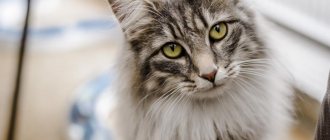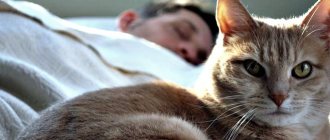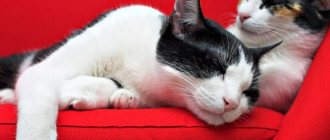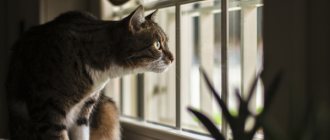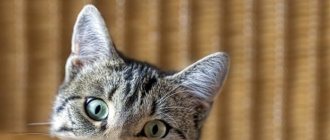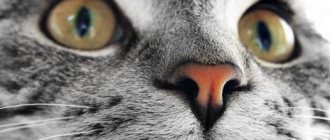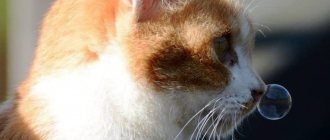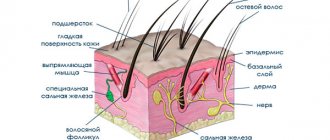From a scientific point of view
"Milk step" is a term used in veterinary medicine to describe the behavior of a kitten when it receives milk from its mother. Kittens tend to massage the belly of a nursing cat, thereby stimulating milk production in the adult animal.
It is believed that when cats purr and move their paws, they fall into childhood. After all, the memory of one of the earliest and most pleasant events in an animal’s life remains in its subconscious forever. In addition, when stomping in one place, accompanied by purring, quiet smacking is often heard.
It is also known that animals separated from their mother early massage a soft blanket or blanket much more often than those who spent the required time with the cat.
A situation where a cat often moves its paws on its owner’s body means that he trusts him and feels comfortable in his presence. The animal does not feel fear, it is caressed, protected, well-fed and grateful. This behavior of the pet indicates that he is attached to the person as to his own mother.
Are there cats that don't have this habit?
Artificially raised kittens that have never fed their mother's milk are deprived of this habit. For this reason, they did not develop a conditioned reflex. Sometimes, when a mother cat has a large amount of milk and few kittens, her babies also do not have the need to trample a person, because they receive food in abundance. They had no need to obtain additional food.
There are many versions of this question, but the only ones who can reliably answer it are our tailed pets. But they don’t allow people into their secret world yet.
Instinctive preparation of a place to rest
Before the domestication process began, cats made their own places to sleep. Often, in order to lie down comfortably, one had to crush the bristling grass with one’s paws. It was also important to make sure the bed was safe for future relaxation.
Cats are by nature cautious and selective - the predatory instincts of wild animals are alive in them and are not reduced. By pressing his owner's paws, the cat checks whether his body is safe enough to relax and fall asleep. With this action, cats may not purr, silently preparing a place for themselves to rest.
Why does a cat purr?
The reasons for rumbling in cats can be very different. Let's look at the most likely and common of them.
- Pleasure and tranquility - the cat is calm, relaxed, full and satisfied, nothing bothers him.
- Communication between mother and kittens - newborn kittens are blind and do not yet know how to communicate by meowing. By purring, the mother lets the babies know that they are safe, and the children show her that they feel good.
- The pet wants to show love and devotion - for the cat this is a gesture of trust, it establishes a kind of connection with a loved one. And after a pleasant game or a delicious meal, he can show gratitude in this way.
- He wants to get something - it could be some kind of treat, a favorite toy, or just affection and attention.
- Preparing for sleep - while purring, cats calm down and relax, sleep will be stronger and sweeter.
- Pain relief – cats may purr if they are injured or sick. A signal is sent to the brain centers of the brain and pain is reduced due to the release of endorphins.
- Presence of disease - purring too often and for a long time may indicate the presence of diseases in the pet. For example, this is one of the symptoms of feline infectious peritonitis.
- Communication with other animals – some cats purr and show interest and friendliness towards other animals. Males may purr around other, older or weaker cats. This is how they show that they will not attack.
- Anxiety and fear - the animal may be worried about an important event or something is bothering it, for example, the appearance of a stranger in the house.
Reference! Some cats purr during labor to calm themselves down and relieve pain.
Selecting a territory
It is believed that the sweat glands on the paw pads of cats are involved in the process of identifying territory. The chemical composition of secretions in all living organisms, including humans, is unique to each individual. Animals can indeed communicate in this way what belongs to them. This is an instinctive process and it occurs spontaneously: a signal is recorded in the pet’s brain about the need to mark the territory. The favorite is reminded of this by the most ancient mental attitudes.
If a cat tramples a person with its paws, this means that the animal appreciates him and wants the owner to always be with him.
Cat massage
There are many guesses why the pet purrs and tramples its owner with its paws. Here are some of them:
- Memories of childhood, or “milk step” - kittens knead their mother with their paws while feeding to quickly obtain milk. This brings them pleasure and is associated in adults with a feeling of comfort, satiety and security.
- Prepares a comfortable place to sleep - tramples the surface on which you are going to sleep for the greatest comfort. The owner's knees may well be suitable for this purpose.
- Gratitude - in this way one can say “thank you” for delicious food, warm shelter, tenderness and affection.
- Therapeutic massage is a common theory that this is how a cat treats its owner from ailments.
- Stress relief – by purring and moving their paws, cats lift their spirits, relax and calm down.
- Unfulfilled sexual instinct - one theory says that if an animal does not have a mate, it may show unambiguous interest.
- Marks its property - cats have glands on their paw pads that secrete a secretion. This is one of the ways to convey to other animals that a person belongs to him.
- Showing trust and love - the pet shows its owner its location, favor, openness and trust. Emphasizes your closeness with a person.
This massage soothes, relaxes and helps relieve stress. But what if claws are used? You can lightly press the cat towards you so that he lies down and stops trampling. You should not scold or drive out an animal if its trust and peace of mind are valuable. It’s better to just put a blanket or pillow on your knees in advance.
Reference! A cat will reflexively retract its claws if you stroke the top of its paws.
Stress relief
Cats often crumple a soft blanket or rug after they have been deprived or offended in some way. For example, they did not give a piece of sausage from the dinner table, although the animal begged for it with all its might. They woke you up or forced you to leave your favorite and already warm place. In this case, the pet often begins to intensively crush various interior items with its paws, however, it does not begin to purr.
Cats crush a person with their paws, splashing out negative emotions. The pet tries to improve his own mood. Often, after stomping around on the blanket for a while, the cat returns to its owner and lies down next to him - this is how the animal shows that it is no longer angry and is ready to continue friendly communication with the person.
What should an owner who is in pain from the “milk step” do?
If a cat tramples you with its paws and at the same time actively releases its claws and scratches your skin, do not rush to drive it away or scold it. Such an attitude can destroy the established trust. Instead of punishment, it is recommended to try more harmless options.
Laying soft cloth
The easiest way is to carefully place a soft blanket or thick clothes under your pet that you don’t mind. Thanks to this cape, the massage will bring extremely pleasant sensations.
If the long and sharp claws continue to scratch even after placing fabric, try distracting the cat with a toy or gently turning it over on its side. Once in a lying position, she will calm down and go to sleep. It is also recommended to simply stroke the paws on top. This action will cause the claws to retract instinctively.
Cat manicure
Timely cat manicure not only prevents scratching and damage to furniture, but also prevents delamination of the claw covers. During the procedure, only the light part is cut off with a nail clipper, and the shortened claw must be trimmed with a file.
If you are afraid of harming your pet, seek help from a groomer or purchase silicone anti-scratch caps. They are fixed to the claws with special glue, which is included with the main kit.
Read also: How is a navel piercing done in a salon?
What you should never do
In most cases, trampling on the owner is a way of showing love, so it should be encouraged, not suppressed. Prohibited actions during the “milk step” include:
- screams;
- repulsion;
- spanking and other types of physical punishment;
How to behave as an owner
While a cat is kneading the human body with its paws, the owner of the animal does not feel entirely comfortable due to the fact that he forgets himself and releases his claws. This, in turn, can bring a feeling of pain, both mild and quite strong.
Under no circumstances should you scold a cat, much less hit it. A loud, menacing voice or a harsh slap can cause misunderstanding and mistrust in a cat. She may begin to avoid the person and become aggressive towards him. Indeed, at the time when an animal tramples its paws on something, it experiences the most tender feelings.
However, you should not endure the pain from claws when in contact with a cat, nor should you turn a blind eye to the fact that the animal can ruin your interior items. The following actions will help minimize the negative consequences of paw trampling:
- Start gently stroking your pet’s paws; after a couple of minutes, the animal will remove its claws, continuing to stomp only on the pads;
- Start stroking your pet more intensively, and then gently lay it on its side;
- Distract your cat from what she is doing. Play with her or hug her.
Having considered the possible reasons why cats begin to knead a person’s body or interior items with their paws, we can see that in the vast majority of cases the animal does not do this because it experiences negative emotions. On the contrary, this is how the pet prepares for rest or shows a trusting attitude towards the owner.
How should you react to this?
There is an opinion (followed by traditional healers) that a cat restores a person’s energy balance
- Most people gratefully accept such an outburst of love and care from a pet. It is enough to caress the cat, rub it behind the ear, and stroke its fur to calm it down.
- If the owner does not like such actions, then you should not reject the pet, much less spank it. It is necessary to distract the animal with a toy or treat, place a pillow or blanket under its paws.
- If, while purring, a cat releases its claws and scratches a person, then you need to shorten the claws at the veterinary clinic or trim them yourself. For this purpose, special scratching posts are used, which can be purchased at a veterinary store.
- If the animal digs its claws into the skin, then you need to pet the pet and pull it down with light movements, lay it down next to it. Such actions will help the cat calm down and stop stretching its paws.
You should not reject the animal while trampling, shout or punish it. Subsequently, the pet may harbor a grudge and even take revenge - mark the territory in the wrong place.
During the milk step, your cat is showing love, care, and trust, and expects the same from you. Scientists have proven that close contact with a pet improves well-being, relieves diseases and even lowers blood pressure. Do not offend your furry pet and be healthy.
What should and should not be done?
Touching and kneading the owner with its paws is a natural behavior for every furry pet. You can’t blame him for this, just like:
- Punish;
- Use physical force;
- Limit your attention.
If a cat tramples with its paws and at the same time releases claws that scratch the skin or tear clothes, the owners can use the following techniques:
- It is necessary to trim the nails, but not too short;
- You can pet your pet;
- You can place a thick blanket under the cat's paws;
- It is worth lightly pressing on the front paws, which will force the pet to remove its claws;
- You can distract your pet's attention by showing his favorite toy;
- It is recommended to lay the cat on its side, stroking its head.
Massaging and purring a cat is the best manifestation of his attention and love. If you decide to punish your pet for this, you risk ruining your relationship with him forever and causing his aggression.
Probable Causes
Experts in the field of animal psychology identify several reasons why cats knead their paws. This ritual has the following explanations and theories:
It is for this reason that cat breeders call this ritual the “milk step.” Owners often notice that the kitten not only wiggles its paws, but also purrs contentedly and even drools with pleasure. This theory is supported by the fact that artificially fed pets are not capable of the “milk step”.
- One of the reasons why cats paw is their natural instincts. Being once wild predators, animals carefully prepared places for rest and overnight: they trampled down hard grass, making the nest cozy and soft. In the wild, representatives of the cat family use grass and leaves to make a nest. To make your sleeping area comfortable and safe, it needs to be put in order. The most convenient way to do this is to crush objects with your paws.
The desire to equip one’s territory, a place to rest and sleep, is also characteristic of modern domestic couch potatoes. And although most pets live in comfortable conditions, nevertheless, they have not lost the ancient instinct of their wild ancestors. In addition, the cat often crushes soft objects with its paws, arranging a nest for birth and future offspring. Often this behavior is a sign of impending labor.
- Hunting instinct. Some experts believe that domestic cats knead a soft surface, obeying the ancient hunting instinct. Predators by nature, pets have not lost the ancient skills of this skill. Their wild counterparts, before jumping on the prey, crush the surface with their paws, testing it for stability and hardness. It is important for a predator that at a crucial moment a branch does not snap under its paw. Fluffy couch potatoes have not lost their natural instincts, but they do not always use them for their intended purpose.
- Territorial version. Some zoologists are inclined to believe that the reason why cats crush their owners' paws is their desire to mark their territory. There are specific glands on the pads of cats' paws, with the help of which they identify their possessions and territory.
Considering its beloved owner to be its property, the animal leaves its scent on his body, making it clear to other individuals that they can no longer have the right to the owner’s attention. Thus, the ritual serves as a kind of marker to mark one’s property and possessions.
- Psychological release. The psycho-emotional tension or stress accumulated by the pet requires release. Some animal psychologists, not without reason, believe that the reason why cats knead the blanket with their paws is self-soothing. At the same time, the animal practically disconnects from the outside world and focuses on its internal sensations. Monotonous paw movements and purring help calm the pet.
This point of view is supported by the fact that during the “milk step” the cat’s body produces endorphins - specific substances, hormones of happiness. They reduce anxiety and fear in pets.
- Other factors. Experienced breeders believe that the reason for the cat ritual is a high degree of trust and love for its owner. Many cat fans believe that animals perform such a ritual for a healing purpose - they treat their owner from various ailments, taking away negative energy.
Another reason why cats massage their paws is sexual behavior. As a rule, in the spring, with increasing daylight hours, the production of sex hormones increases, which in some individuals is accompanied by a “milk step”. The variety of theories, versions and guesses regarding a peculiar ritual inherent only to representatives of the feline family once again testifies to the mystery and enigma of domestic cats.
None And here is more information about how to remove a cat from a tree yourself and with the help of special services.
[custom_ads_shortcode2]
What cats don't trample on humans?
Not all cats paw at the blanket or press their owner's belly. It doesn't depend on the breed, it's just that not all purrs have this instinct. Don't worry if your pet doesn't give you a massage, this in no way means that he doesn't love you. Perhaps the kitten grew up without a mother and was bottle-fed, and therefore there was no need to stimulate milk production.
Interesting things on the site:
Top 15 calmest cat breeds
Hypoallergenic cat breeds
Trampling for possible partners
Cats have an additional reason for trampling. They may purr, stretch, and stomp while lying on their sides to communicate to male cats that they may be suitable for possible mating.
However, if they are immediately ready to mate, they will not knead their paws, but will instead raise their pelvis with their tail to the side.
Whether your cat is giving you a massage to show you affection or to make a statement, kneading is a natural, instinctive, and common cat behavior.
